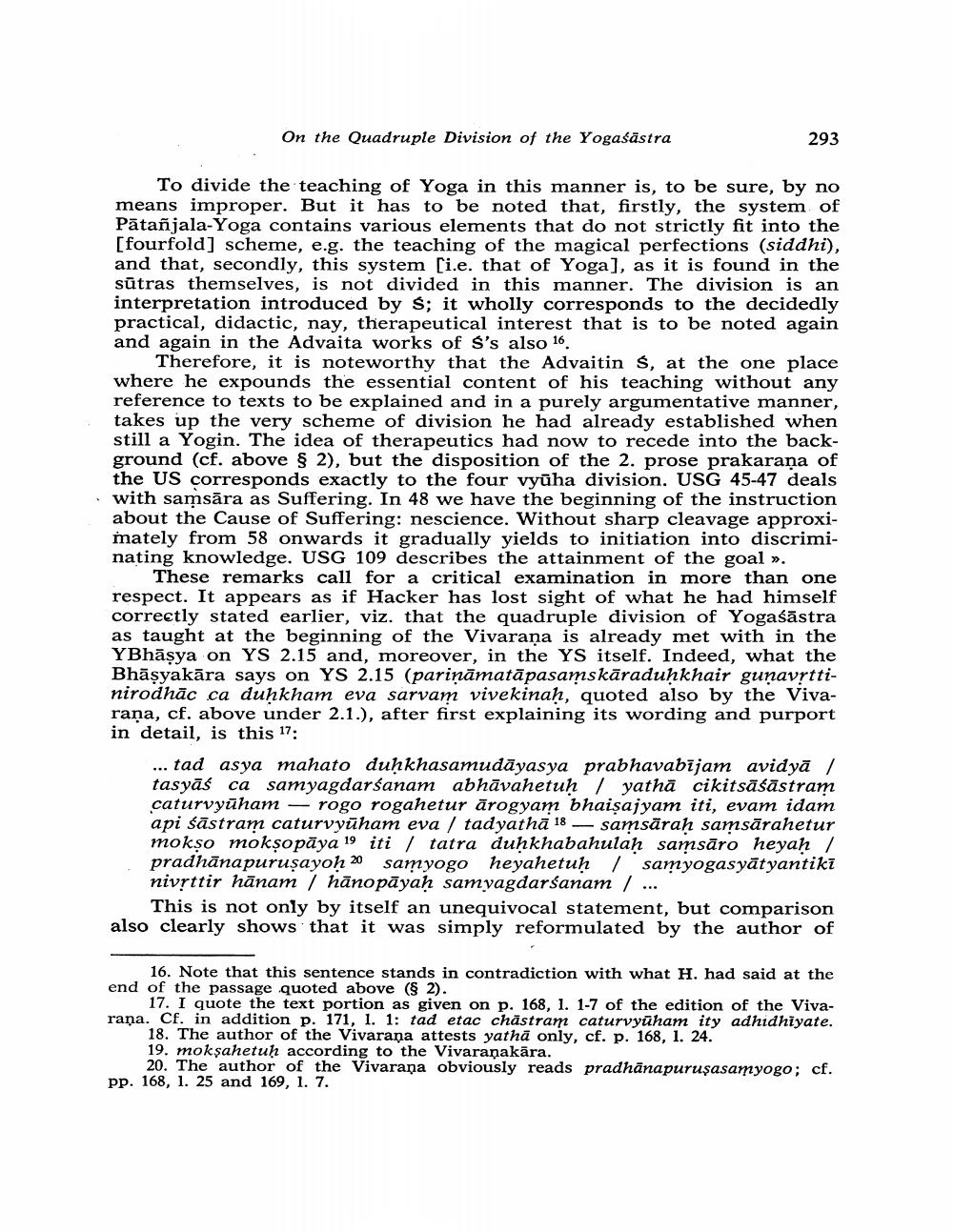Book Title: On Quadruple Division Of Yogasastra Author(s): A Wezler Publisher: A Wezler View full book textPage 5
________________ On the Quadruple Division of the Yogaśästra 293 To divide the teaching of Yoga in this manner is, to be sure, by no means improper. But it has to be noted that, firstly, the system of Patañjala-Yoga contains various elements that do not strictly fit into the [fourfold] scheme, e.g. the teaching of the magical perfections (siddhi), and that, secondly, this system [i.e. that of Yoga], as it is found in the sūtras themselves, is not divided in this manner. The division is an interpretation introduced by $; it wholly corresponds to the decidedly practical, didactic, nay, therapeutical interest that is to be noted again and again in the Advaita works of S's also 16. Therefore, it is noteworthy that the Advaitin s, at the one place where he expounds the essential content of his teaching without any reference to texts to be explained and in a purely argumentative manner, takes up the very scheme of division he had already established when still a Yogin. The idea of therapeutics had now to recede into the background (cf. above $ 2), but the disposition of the 2. prose prakarana of the US corresponds exactly to the four vyūha division. USG 45-47 deals with samsāra as Suffering. In 48 we have the beginning of the instruction about the Cause of Suffering: nescience. Without sharp cleavage approximately from 58 onwards it gradually yields to initiation into discriminating knowledge. USG 109 describes the attainment of the goal ». These remarks call for a critical examination in more than one respect. It appears as if Hacker has lost sight of what he had himself correctly stated earlier, viz. that the quadruple division of Yogaśāstra as taught at the beginning of the Vivarana is already met with in the YBhāṣya on YS 2.15 and, moreover, in the YS itself. Indeed, what the Bhāṣyakāra says on YS 2.15 (parināmatāpasamskāraduḥkhair guņavrttinirodhāc ca duhkham eva sarvam vivekinah, quoted also by the Vivarana, cf. above under 2.1.), after first explaining its wording and purport in detail, is this 17 ... tad asya mahato duḥkhasamudāyasya prabhavabījam avidyā / tasyāś ca samyagdarśanam abhāvahetuh / yathā cikitsāśāstram caturvyūham — rogo rogahetur ārogyam bhaisajyam iti, evam idam api śāstram caturvyūham eva / tadyathā 18 — samsāraḥ samsārahetur mokso moksopāya 19 iti / tatra duḥkhabahulah samsāro heyah / pradhānapuruşayoḥ 20 samyogo heyahetuh / samyogasyātyantiki nivettir hānam / hānopāyaḥ samyagdarśanam / ... This is not only by itself an unequivocal statement, but comparison also clearly shows that it was simply reformulated by the author of 16. Note that this sentence stands in contradiction with what H. had said at the end of the passage quoted above (s 2). 17. I quote the text portion as given on p. 168, 1. 1-7 of the edition of the Vivarana. Cf. in addition p. 171, 1. 1: tad etac chăstram caturvyūham ity adhidhiyate. 18. The author of the Vivarana attests yathā only, cf. p. 168, 1. 24. 19. mokşahetuh according to the Vivaranakära. 20. The author of the Vivarana obviously reads pradhānapuruşasamyogo; cf. pp. 168, 1. 25 and 169, 1. 7.Page Navigation
1 ... 3 4 5 6 7 8 9 10 11 12 13 14 15 16 17 18 19 20 21 22 23 24 25 26 27 28 29 30 31 32 33 34 35 36 37 38 39 40 41 42 43 44 45 46 47 48 49
